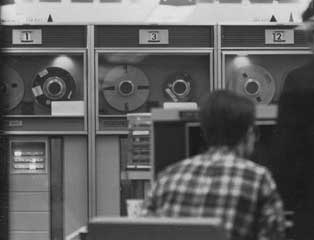 I was alerted to the presence online of a transcript of an “online computer conference” I organized in late 1973 when I was a professor at Northwestern University, and running my project called Computers And Teaching [CAT]. Murray Turoff, who was with the (US) Office of Emergency Preparedness had been running conferences limited to government participants, and Bob Johansen (while a graduate student) and I got the idea of doing a conference that would combine physical presence and remote presence, which we held in November, 1973. The PLATO-IV system, of course, had included its own internal online conferencing (serving maybe a couple thousand people at the time), but that was limited to people with PLATO terminals. Our goal was to expand conferencing well beyond that group by using an interactive system I had built.
I was alerted to the presence online of a transcript of an “online computer conference” I organized in late 1973 when I was a professor at Northwestern University, and running my project called Computers And Teaching [CAT]. Murray Turoff, who was with the (US) Office of Emergency Preparedness had been running conferences limited to government participants, and Bob Johansen (while a graduate student) and I got the idea of doing a conference that would combine physical presence and remote presence, which we held in November, 1973. The PLATO-IV system, of course, had included its own internal online conferencing (serving maybe a couple thousand people at the time), but that was limited to people with PLATO terminals. Our goal was to expand conferencing well beyond that group by using an interactive system I had built.
Online_Computer_Conference_in_1973 (PDF) contains the transcript of this 1973 online conference. (The PDF has been saved in the ERIC system for 43 years. Thank goodness for government-sponsored ed research archives.) If you notice the timestamps on the messages, some interchanges were in real time and many were asynchronous. The time-independence of the conference did actually confuse some of the participants because it was such a new concept. (And I had not implemented many of the commonsense conference components you’d find in a modern system.)
At the time I had a Texas Instruments thermal “TTY” style terminal I used at home on a separate phone line installed for the dial-up modem. The terminal belonged to my project and was well beyond anything an individual would have at home. IT was portable in the sense that it had a cover and handle like a big suitcase — and weighed maybe 25 lbs. I also had another dozen CRT style terminals in my lab at the university. And one terminal in my office. A true luxury in those days.
The online conference transcript displays messages in chronological order. Several participating locations had multiple human participants. Particularly Resource One (a community computing center in San Francisco) and the University of Michigan. Participants had to dial in to the main computer and could type while online, so this was an expensive process. To cut the connect time, a couple of locations batched their comments locally, then uploaded them by connecting their computer to ours. You might call this a precursor of email. My recollection is that Arpanet was young in those days, being one of the first networks to include email as a basic capability. PLATO-IV had its equivalent of email in its notes program, which allowed people to create threaded discussions.
The library of NJIT has a collection of all the early reserach reports of the development of EIES from 1974 on. This was the NSF effort under the leadership of Murray Turoff and Roxanne Hiltz.
EIES was the first social network but it was designed to allow groups within hte system to have developed special group functions to facilitate the type of communication process that was better suited to carry out their objections. We also did many experiments on groups making decisions and other objectives for asynchronous computer conferencing. The link to see the list of research reports and other associated items is at http://library.njit.edu/archives/cccc-materials/
We are planning to add additional items to this free library resource next semester at njit.
There is also some material from the earlier EMISARI system at the Office of Emergency Preparedness. EIES=Electronic Information Exchange System EMISARI =Emergency Management Information System and Reference Index.
The people who create the Well (the explicit first social network system were one of the early EIES groups that used their experience on EIES to design the Well.
User manuals for EIES and EMISARI are in this list of material and also some the special group designs. Feel free to contact me if you have questions or comments on what you find
murray.turoff@gmail.com
there is also some material on my njit website which was frozen in 2007 when i retired
http://web.njit.edu/~turoff The Delphi Method book (for free on htat web site) has a final chapter on the early computer conferencing work. The most complete work is the “network nation” book by hiltz and turoff which is still in print by MIT press (it has one new chapter in this 1993 version which has all the rest of the material from the original 1978 version.
computer conferencing work.